Topical flagellin-mediated innate defense against Candida albicans keratitis
- PMID: 21310913
- PMCID: PMC3109016
- DOI: 10.1167/iovs.10-5928
Topical flagellin-mediated innate defense against Candida albicans keratitis
Abstract
Purpose: This study was conducted to investigate whether flagellin, the sole ligand of Toll-like receptor-5 (TLR5), induces an innate defense that is sufficient to protect injured corneas from Candida albicans.
Methods: Scarified corneas of adult B6, TLR5(-/-), Camp(-/-) (cathelicidin-related antimicrobial peptide), or PMN-depleted mice were pretreated with Pseudomonas aeruginosa flagellin or a mutant and then were inoculated with C. albicans. The corneas were compared for disease progression, cytokine and Camp expression, and PMN infiltration before and after C. albicans infection. Disease progress was recorded by digital photography and clinical scoring, cytokine levels were determined by ELISA, the levels of Camp gene product were assessed by Western blot, and PMN infiltration was measured by MPO determination and immunohistochemistry.
Results: Topical application of flagellin induced profound protection against Candida keratitis in a TLR5-dependent manner. The improved disease outcome including reduced tissue inflammation and rapid functional recovery can be attributed to a marked decrease in fungal burden at the early stage of C. albicans infection in flagellin-exposed B6 mouse corneas. Although both PMN infiltration and Camp upregulation contributed to corneal innate defense against fungal infection, Camp ablation totally, and PMN depletion partially, abrogated flagellin-induced fungal clearance in B6 mouse corneas.
Conclusions: Flagellin induces a strong innate defense and promotes robust resistance to C. albicans infection in the cornea. Topical flagellin or its mimetic may become a new prophylactic agent for preventing contact lens or trauma/injury-associated microbial keratitis.
Figures
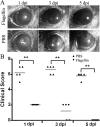

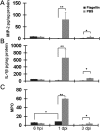

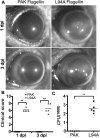

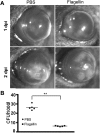
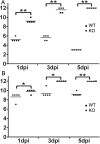

Similar articles
-
Topical flagellin protects the injured corneas from Pseudomonas aeruginosa infection.Microbes Infect. 2010 Nov;12(12-13):978-89. doi: 10.1016/j.micinf.2010.06.007. Epub 2010 Jul 1. Microbes Infect. 2010. PMID: 20601077 Free PMC article.
-
ISG15 in Host Defense Against Candida albicans Infection in a Mouse Model of Fungal Keratitis.Invest Ophthalmol Vis Sci. 2017 Jun 1;58(7):2948-2958. doi: 10.1167/iovs.17-21476. Invest Ophthalmol Vis Sci. 2017. PMID: 28599020 Free PMC article.
-
Role of IL-36γ/IL-36R Signaling in Corneal Innate Defense Against Candida albicans Keratitis.Invest Ophthalmol Vis Sci. 2021 May 3;62(6):10. doi: 10.1167/iovs.62.6.10. Invest Ophthalmol Vis Sci. 2021. PMID: 33970198 Free PMC article.
-
Interferon regulatory factor-1 in flagellin-induced reprogramming: potential protective role of CXCL10 in cornea innate defense against Pseudomonas aeruginosa infection.Invest Ophthalmol Vis Sci. 2013 Nov 15;54(12):7510-21. doi: 10.1167/iovs.13-12453. Invest Ophthalmol Vis Sci. 2013. PMID: 24130180 Free PMC article.
-
The corneal expression of antimicrobial peptides during experimental fungal keratitis.Curr Eye Res. 2010 Oct;35(10):872-9. doi: 10.3109/02713683.2010.495812. Curr Eye Res. 2010. PMID: 20858107
Cited by
-
Matrix Metalloproteinase-13 as a Target for Suppressing Corneal Ulceration Caused by Pseudomonas aeruginosa Infection.J Infect Dis. 2015 Jul 1;212(1):116-27. doi: 10.1093/infdis/jiv016. Epub 2015 Jan 13. J Infect Dis. 2015. PMID: 25589337 Free PMC article.
-
Chitinase 3-Like 1 Promotes Candida albicans Killing and Preserves Corneal Structure and Function by Controlling Host Antifungal Responses.Infect Immun. 2015 Oct;83(10):4154-64. doi: 10.1128/IAI.00980-15. Epub 2015 Aug 3. Infect Immun. 2015. PMID: 26238714 Free PMC article.
-
Protective role of murine β-defensins 3 and 4 and cathelin-related antimicrobial peptide in Fusarium solani keratitis.Infect Immun. 2013 Aug;81(8):2669-77. doi: 10.1128/IAI.00179-13. Epub 2013 May 13. Infect Immun. 2013. PMID: 23670560 Free PMC article.
-
Role of host-defence peptides in eye diseases.Cell Mol Life Sci. 2011 Jul;68(13):2201-13. doi: 10.1007/s00018-011-0713-7. Epub 2011 May 17. Cell Mol Life Sci. 2011. PMID: 21584809 Free PMC article. Review.
-
Antimicrobial compounds in tears.Exp Eye Res. 2013 Dec;117:53-61. doi: 10.1016/j.exer.2013.07.014. Epub 2013 Jul 20. Exp Eye Res. 2013. PMID: 23880529 Free PMC article. Review.
References
-
- Thomas PA. Fungal infections of the cornea. Eye (Lond). 2003;17:852–862 - PubMed
-
- Thomas PA, Geraldine P. Infectious keratitis. Curr Opin Infect Dis. 2007;20:129–141 - PubMed
-
- Galarreta DJ, Tuft SJ, Ramsay A, Dart JK. Fungal keratitis in London: microbiological and clinical evaluation. Cornea. 2007;26:1082–1086 - PubMed
-
- Ritterband DC, Seedor JA, Shah MK, Koplin RS, McCormick SA. Fungal keratitis at the New York Eye and Ear Infirmary. Cornea. 2006;25:264–267 - PubMed
Publication types
MeSH terms
Substances
Grants and funding
LinkOut - more resources
Full Text Sources
Other Literature Sources
Medical
Research Materials
Miscellaneous

